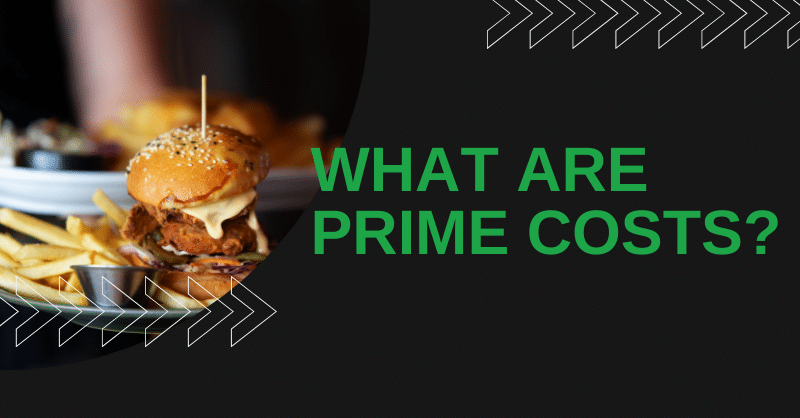Updated on: February 8, 2025
Restaurants have numerous expenses.
These include raw material costs like food and inventory, total labor, payroll costs, employee benefits (like health insurance), utilities, rent, and more. Restaurant expenses can be divided into different categories and classifications to help you track where you spend the most money and how your expenses compare to total sales. Knowing this can help you set appropriate menu prices and stay on top of all expenses.
As a restaurant owner or manager, you may have asked yourself, “What are prime costs?” If so, you’re not alone.
Prime costs are all expenses directly related to producing a good or service. Think of them as direct production costs because prime costs do not account for indirect costs. These costs must also be considered when accounting for restaurant costs. Indirect costs are business expenses not directly related to the production of your product or service.
Examples of direct costs versus indirect costs
Direct costs
- Cost of materials, specifically food costs (Ingredients)
- Labor expenses (hourly employees)
Indirect costs
- Manager salary
- Advertising
- Physical location utilities
What’s the difference between prime costs and other costs?
You may wonder, “What are the differences between a prime cost and any other cost?”
While each metric is individually important, there are substantial differences when it comes to specific costs. Breaking costs down into categories allows you a more in-depth look at targeted aspects of your business.
For example, gross income specifically accounts for all costs related to the business before taxes are deducted. Similarly, labor cost is a measure of the overall cost of employee payroll as well as manager salary.
Prime Cost is Made Up of Food Costs and Labor Costs
Prime cost allows you to specifically identify the direct cost associated with producing a product such as a plate of food. Typically, prime cost includes food cost and labor costs. For example, when making a pizza, you have the food costs for ingredients, and the labor costs for the person who kneads the dough and builds the pizza. These labor costs mean every cost associated with paying the staff who create the dish. Payroll and wages, payroll taxes, and health insurance and other benefits are all included.
While a low food cost percentage can be an indicator of success, different dishes take a different amount of labor. Prime cost formula takes all of this into account to give you an accurate look at how much your menu items take to create. A healthy prime cost will put you in a good position to be successful.
What are the applications of prime costs for restaurants?
Reducing production costs is essential to increase ROI (return on investment) when managing any business.
In the restaurant business, your product is the plate of food you serve. If you offer a sit-down experience with wait staff, your service is the experience guests have in your restaurant.Since your prime cost provides the baseline for your ROI, you should be aware of its fluctuations weekly or monthly.
Some reasons for these fluctuations could include inflation of ingredient prices or inefficient and irregular processes. Without knowledge of your prime costs, it’s difficult to know the production processes’ effect on the business overall.
The prime cost metric can give insight into the effectiveness of a manager or employee. It could also show you that certain menu items need a price increase due to market inflation.
How do you calculate prime cost?
As with most business metrics, the prime cost formula is unique.
The prime cost calculation is quite simple: take the cost of raw materials to produce an individual unit and combine it with the cost of labor specifically used for that unit:
Total prime cost = Direct material cost + Direct labor cost
Calculate the prime cost percentage using this formula:
Prime Cost Percentage = Prime Cost ÷ Total Food and Beverage Sales x 100
Once you know the percentage, you know the prime cost ratio, essentially the number you get when calculating the percentage. Your prime cost ratio should be around 50% of costs and at least below 65-70%. 30-35% of your revenue is typically insufficient to cover other costs, such as rent. This can vary, so make sure you understand your prime cost targets and make adjustments when you aren’t hitting those.
You can broaden your analysis to include the prime costs of a specific shift. This involves considering both direct material expenses and the total labor hours for that shift.
If you notice a negative trend in this large scope data, then you can visit individual items produced during that shift. Use the collected data to identify shortcomings of individual products or processes.
Differences between prime cost and conversion cost
Those savvy in business metrics may wonder how prime and conversion costs differ. Although both have a focus on the production process and seek to capture the cost of production, they provide two unique perspectives.
Prime cost provides an overview of all direct expenses, direct materials, and direct labor costs (usually the single largest expense a business has), related to production.
Conversion costs by definition provide an overview of all direct and indirect expenses related to converting those raw materials into your product. Namely, the conversion costs related to your product may also include other overhead costs like electricity to run cooktops, manager salaries, delivery fees, and other additional costs that aren’t always obvious.
Although these metrics are different, it would be beneficial to consider the data of both to truly maximize your outcomes.
Prime cost limitations
As with other business metrics, prime cost has its own specific uses.
It’s not an indication of the performance of a business as a whole. There are more appropriate metrics to identify the value of a company such as gross income. That means uses for prime cost are usually limited to identifying trends in individual unit production costs. Although the scope of prime costs can be expanded, you must consider that the data will lose some accuracy.
If you want an overview of labor costs including salaries, then the prime cost equation will not be appropriate. Similarly, if you have many indirect material expenses that contribute to the production of your unit, then prime cost may be very limited in its usefulness to you.
What is the average prime cost of a restaurant?
Prime cost is most useful when analyzed against past data, but it can also be valuable compared to other restaurants. This insight can assist you in establishing goals as you begin utilizing prime cost to enhance your ROI.
The average expected restaurant prime cost is around 55 to 65%.
Of course, there is wiggle room here as each restaurant is unique and may have different needs. Quick-service and full-service restaurants will naturally have differences in things like raw materials costs, labor wages, minimum sales price, and various production costs.
However, no matter what part of the restaurant industry you’re in, the general concept is the same. If your prime cost is 60%, 40% of the sale will go toward utilities, administrative costs, and salaries.
Also, to establish profit, you must consider that higher prime costs mean higher product costs. You may lose customers or your business if your sale price is too high due to inefficient production expenses. It’s no wonder tracking your prime costs is exceptionally important.
How to lower prime costs
We’ve explained what prime cost is, how to calculate it, and what it measures. Now what? As previously mentioned, prime cost affects the baseline for your product’s sale price. If you can lower the prime cost associated with your product you have two possible outcomes:
- You can reduce the actual cost to the customer, or
- The business earns more money per sale
Either result is definitely something to strive for. The key is to identify reasonable room for improvement and set achievable goals based on your prime cost data. For example, if two shifts have a similar production outcome but their prime cost differs, then you can study the process differences and implement changes in the less efficient shift.
Understanding prime costs is important for your restaurant
Prime cost is an important metric that can help business owners identify strengths and weaknesses in their production processes.
For a restaurant, production costs typically include food expenses, inventory costs, and employee wages.
Allocate time to collect prime cost data and assess it weekly or monthly. Managers and owners can use this information to establish achievable goals focused on reducing production costs. This approach will enhance value for both customers and the business overall.
Prime cost has a specific function similar to other metrics. While it’s not always useful within its own limited context, it is very efficient at measuring production costs and helping to identify process issues.
What solutions are there for calculating prime costs in my restaurant?
As you can tell, the concept of prime costs can become quite technical.
You shouldn’t be expected to know exactly how to calculate them. However, a good basic understanding is helpful, and that’s what we hoped to provide in this post.
Does collecting prime cost data seem daunting? Then consider our restaurant reporting and analytics software. In addition to tracking prime cost data, we provide product margin analysis, geographical analysis, and live inventory management, enabling you to monitor every aspect of your restaurant’s performance.
Contact us today to schedule a free, personalized demo showing you how.






